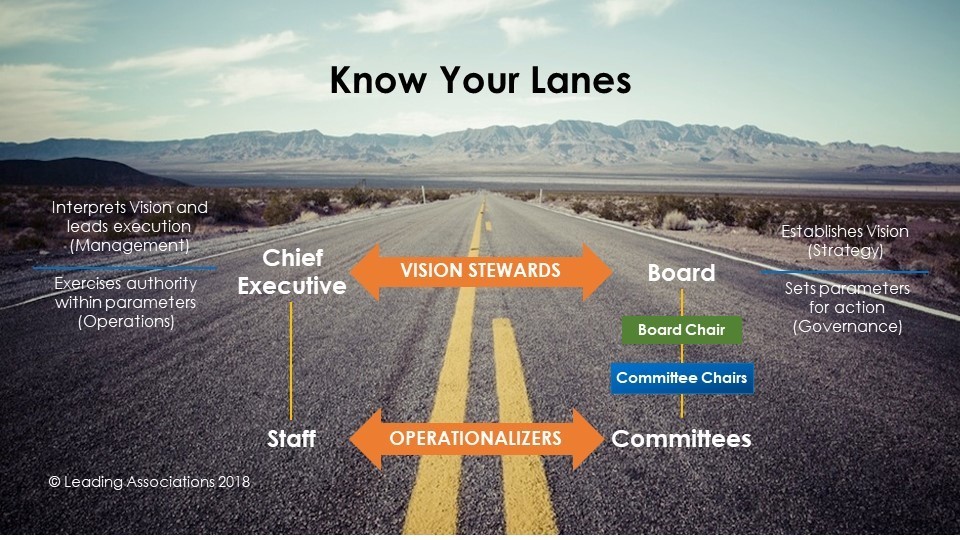Challenges in board of directors/staff relationship generally arise from three types of board engagement: disengaged, over-engaged, or engaged in the wrong way.
Let’s look at each area, then explore key strategies for overcoming the challenges presented.
Disengaged
Staff with a disengaged board may see it as a blessing or a curse, depending on the degree to which the organization is staff-driven and the strength of the Chief Staff Executive (CSE). The board may have fallen into a passive role because a strong executive “trained” them to be passive, or by default because it lacks strong leadership or experience among its members. Or the board lacks meaningful work, clear roles, and responsibilities.
Board meetings in such organizations are typically staff-driven, perhaps even “chaired” by the CSE more so than the chief elected officer. Staff report out what they’re working on. Board members listen passively to staff and committee reports. The extent of board engagement is to ask clarifying questions once in a while: “What was the date of the conference, again?” Most board decisions/votes are rubber-stamps of staff recommendations.
Generally speaking, though, most association executives want strategic direction from the board. Without it, they either take their best guesses at where they think the organization should go, or stay in an operationally reactive mode, perhaps rudderless. While a strong staff may be a driver of this dynamic, it may also arise from a lack of understanding by the board of its roles and responsibilities in strategy and governance.
Over-Engaged
On the flip-side, if the board is over-engaged, staff feels micromanaged, board meetings get deep into operational discussions and tend to be much longer than they should be. Organizations with over-engaged boards often became that way for one or more of the following reasons:
- Transitions: The board recently transitioned from an all-volunteer organization to employing an executive (or hired an executive after previously having an administrative assistant), so they’ve been accustomed to managing daily operations as well as governing.
- Mindset: Board members have operational-level day jobs, so that’s the mindset they bring to the board.
- Limited Volunteers: The organization has a shallow pool of volunteers, so board members take on what should be committee-level responsibilities; and/or
- Previous Experience: The board got “burned” by a previous executive and feels the need to watch organizational operations more closely.
Engaged in the Wrong Way
What is the “wrong kind” of engagement? The list is long. But in summary, it is engagement that is a reflection of the board’s own dysfunctional interpersonal/cultural dynamics being translated into its relationship with staff (or vice versa).
How to Establish the “Right Kind” of Board/Staff Engagement
So what’s the “right kind” of board engagement with staff? The strategies to address the three challenges in board/staff engagement are:
- Disengagement > Stay in your lane and establish meaningful work and meaningful roles.
- Over-Engagement > Establish the board’s trust in staff’s competence and/or delegate committee-level responsibilities.
- Engaged in the wrong way > Get your house in order

- Stay In Your Lane
Lack of engagement by the board/over engagement of staff has at its root a lack of meaningful work or a meaningful role for the board. The problem is that either the board or staff are straying outside of their respective lanes or staying in the shoulder. To stay in your lane on the highway, you need to see the lines painted on the road. Similarly, with board/staff relationships.
"rEvolutionary Governance™ is built on the idea that every association, regardless of size and resources, can operate optimally at the stage of evolution it is in now."
There is plenty of work to be done in the board’s lane; if the staff moves into the board’s lane (providing strategic direction, setting policies) or the board is stuck on the shoulder because it doesn’t know what lane to drive in, then the board will struggle to find meaningful work and become a rubber-stamper of staff initiatives.
- Trust Instead of Micromanagement
If the board’s behavior is a legacy of previous experience, get clear on that and get over it. Live in the present moment. If your current staff is competent, get the heck out of operations. If you’re doing committee-level work, expand your volunteer bench strength and delegate. Shift your focus to directing and governing, not doing or scrutinizing the work of the organization.If the board feels compelled to micromanage staff, the real issue is a lack of trust in the executive’s competence. If that’s the case, the board needs to exercise one of its key responsibilities – hiring and evaluation of the executive.
- Get Your House in Order
If the board/staff relationship is strained by any or all of the three categories of dysfunction detailed in my previous article “Overcoming Board Dysfunction and Optimizing Function: A Simple Framework,” employ the strategies outlined therein.Creating the right kind of Board engagement is key to healthy Board/staff working relationships. Oftentimes, an unbiased outside perspective can be the bridge to guide parties to a win-win resolution. Need help? Leading Associations has helped hundreds of associations strengthen Board/staff relationships. Contact us to learn about free resources and complimentary Board Health Test.
"rEvolutionary Governance™ is built on the idea that every association, regardless of size and resources, can operate optimally at the stage of evolution it is in now."
About the Author
 Jeff Arnold, MAM, CAE, is CEO of Leading Associations which supports professional associations by bringing a full spectrum of board, management and operational solutions that help them work through challenges that inhibit progress, and grow membership.
Jeff Arnold, MAM, CAE, is CEO of Leading Associations which supports professional associations by bringing a full spectrum of board, management and operational solutions that help them work through challenges that inhibit progress, and grow membership.
Jeff brings a combination of association experience and formal education to Leading Associations’ clients. His present responsibilities include dealing with both the strategic and tactical aspects of running associations. His special areas of expertise include working with boards and committees, certification, training programs, and membership systems. You can reach Jeff on LinkedIn or via email.

